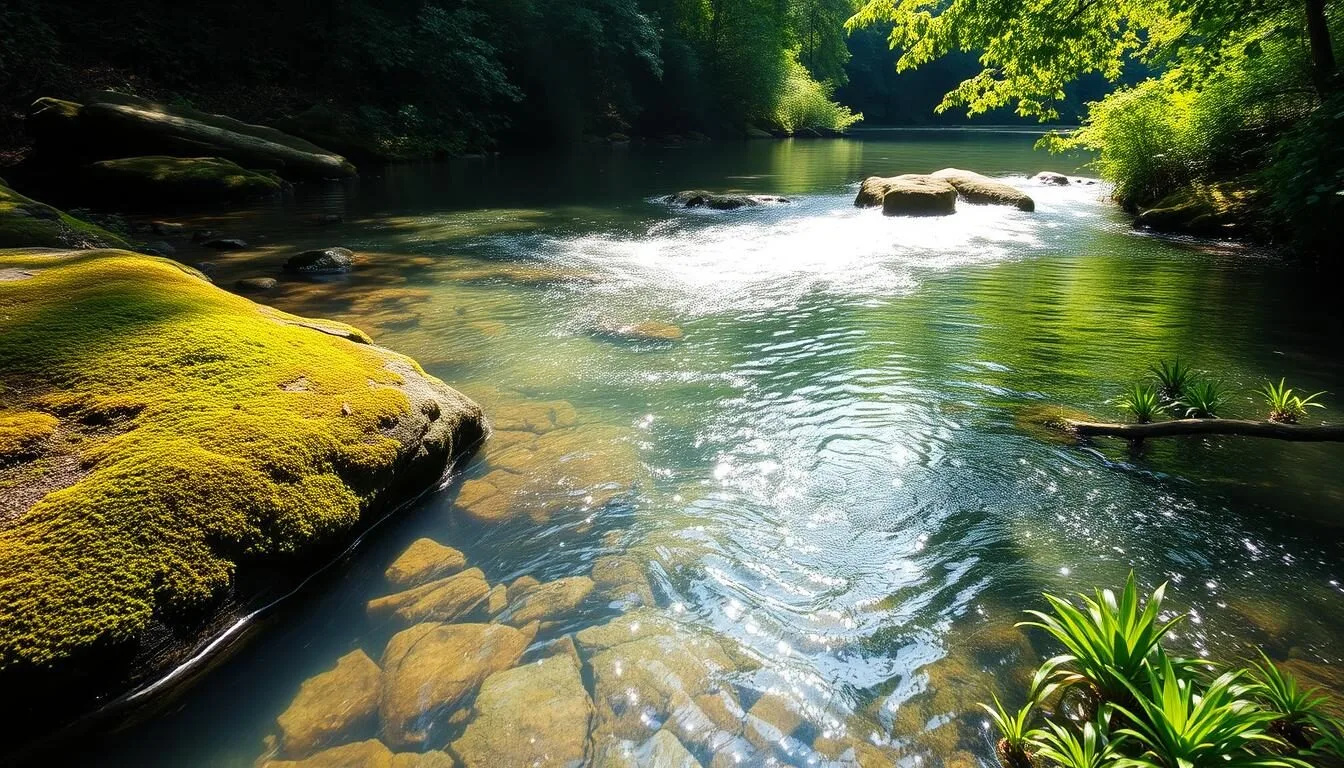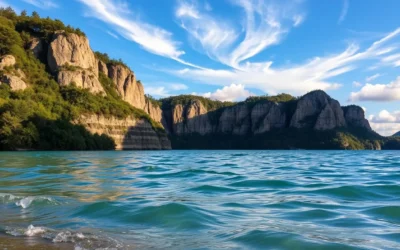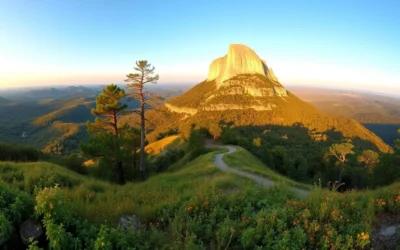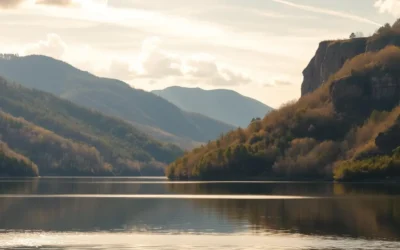You are about to explore one of Arkansas’s most breathtaking natural attractions. Imagine a spring that pumps out a staggering nine million gallons of water per hour. This is the reality at Mammoth Spring State Park, a haven for nature enthusiasts and history buffs alike.
As you visit this incredible state park, you’ll discover a range of attractions, including the vibrant blueish-green spring, the historic Frisco Depot Museum, and a fish hatchery. The park is also connected to Grand Gulf State Park in Missouri through an underground water system, adding to its unique charm.
This guide will walk you through the top adventures and activities to enjoy at the park, ensuring you’re well-prepared for an unforgettable experience.
Discovering Mammoth Spring State Park
As you step into Mammoth Spring State Park, you’re immediately immersed in a world of natural beauty and rich history. The park is a haven for those looking to explore the great outdoors and uncover the secrets of the past.
The Natural Wonder of Mammoth Spring
Mammoth Spring is one of the largest springs in the United States, producing over nine million gallons of water per hour. This natural wonder is a sight to behold, with its crystal-clear waters and lush surroundings creating a breathtaking scene.
The spring’s blueish-green waters are not only visually stunning but also a testament to the unique geology of the area. As you explore the spring, you’ll gain a deeper appreciation for the natural forces that have shaped this incredible resource.
Brief History of the Park
The area around Mammoth Spring has been inhabited for centuries, with indigenous peoples first drawn to the spring’s life-giving waters. Later, European settlers arrived, and the spring played a crucial role in the development of the surrounding community.
- The establishment of Mammoth Spring State Park as a protected natural area in Arkansas.
- The relationship between indigenous peoples and the spring.
- The impact of European settlement on the area’s development.
- The various uses of the spring throughout history, from powering mills to generating electricity.
- The importance of reading the informational history boards throughout the park.
By exploring the park’s history through its informational history boards, you’ll gain a richer understanding of the area’s past and its significance. Take your time to read through these boards as you explore the park, and you’ll leave with a deeper appreciation for Mammoth Spring State Park.
The Magnificent Mammoth Spring
As you step into Mammoth Spring State Park, the breathtaking beauty of the spring immediately captures your attention. The spring is a natural wonder that boasts an incredible flow of water, making it one of the largest and most impressive in the United States.
The Source of Nine Million Gallons Per Hour
The Mammoth Spring is a marvel of nature, producing approximately nine million gallons of water every hour. This enormous volume of water creates a stunning visual effect as it flows into the pools and surrounding areas. The constant flow of water maintains a consistent ecosystem, supporting a variety of aquatic life.
The spring’s water originates from deep within the earth, traveling through underground passages before emerging at the surface. This journey through the earth’s layers imbues the water with unique minerals and properties that contribute to its distinctive characteristics.
The Unique Blueish-Green Waters
The water flowing from the Mammoth Spring appears blueish-green due to the way light interacts with the minerals present in the water. The high concentration of calcium carbonate and other minerals scatters light, giving the water its vibrant color. This phenomenon is further enhanced by the clarity of the water, allowing visitors to see deep into the spring pools.
Some key features of the spring water include:
- The constant 58-degree temperature, which supports a unique ecosystem around the spring.
- The clarity of the water, which allows for deep visibility into the spring pools from various viewing platforms.
- The various pools formed by the spring, each differing in appearance and characteristics.
Visitors can enhance their experience by viewing the spring during the best times of day when sunlight highlights the vibrant colors of the water. The combination of natural light and the spring’s unique properties creates a truly unforgettable sight.
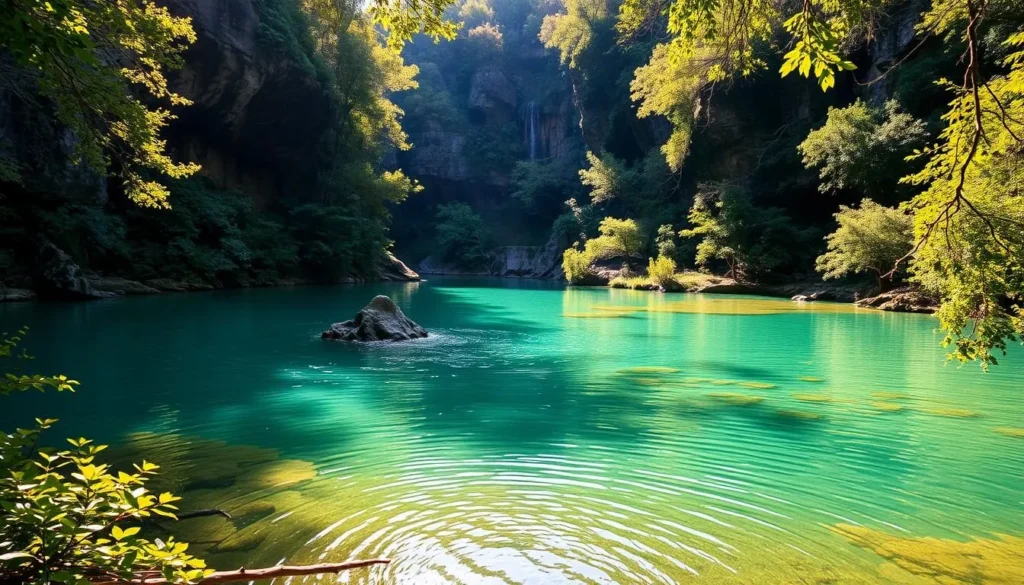
Exploring the Spring Trail
The Spring Trail in Mammoth Spring State Park offers a unique opportunity to witness the park’s breathtaking scenery. As you walk along this trail, you’ll encounter various viewpoints that showcase the spring and its surroundings in different ways.
Trail Features and Highlights
The Spring Trail is designed to give visitors an immersive experience of the park’s natural beauty. Along the way, you’ll notice the unique blueish-green waters of the spring, which are a result of the high concentration of minerals. The trail also features interpretive signs that provide information about the local flora and fauna, enhancing your understanding and appreciation of the ecosystem.
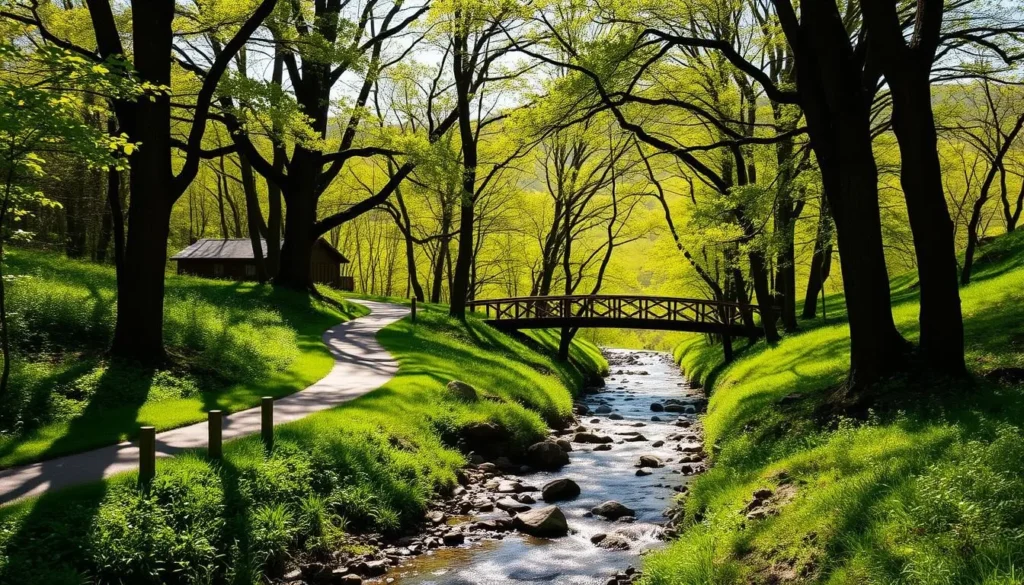
Best Viewpoints Along the Way
There are several viewpoints along the Spring Trail that are particularly noteworthy. One of the best spots is near the spring’s source, where you can observe the nine million gallons of water flowing per hour. The optimal time to visit this viewpoint is early morning or late afternoon when the light is soft, reducing glare on the water and enhancing the colors.
| Viewpoint | Best Time to Visit | Notable Features |
|---|---|---|
| Spring’s Source | Early Morning, Late Afternoon | Water Flow, Mineral Deposits |
| Riverbank | Midday | Wildlife, Vegetation |
| Overlook | Sunset | Panoramic Views, Colorful Skies |
As you continue along the trail, you’ll notice how the views change with the seasons. In spring, the surrounding landscape is lush and green, while in autumn, the foliage turns vibrant shades of orange and red. Understanding these seasonal changes can help you plan your visit to coincide with the best viewing conditions.
Visit the Historic Frisco Depot Museum
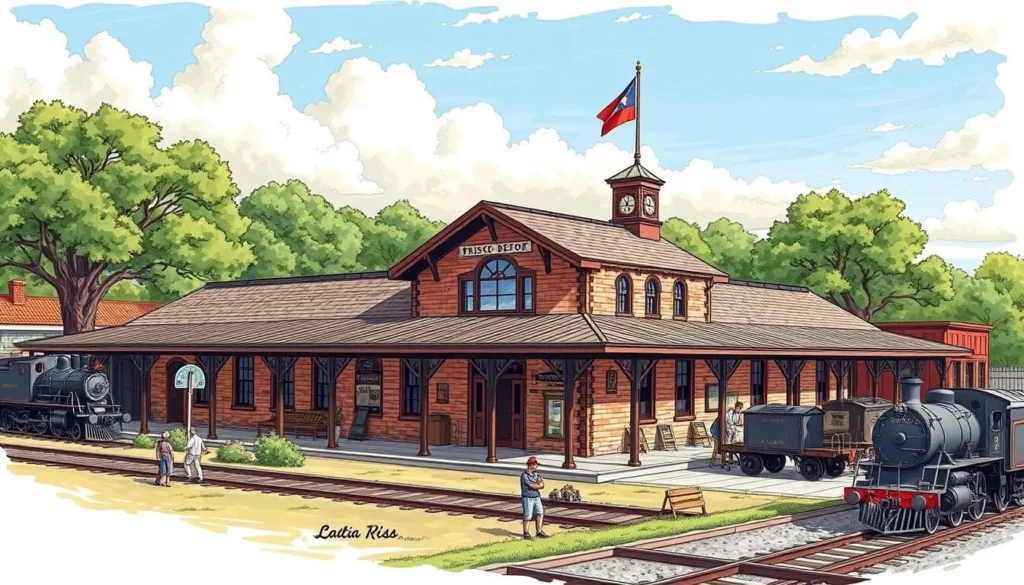
Step into the past at the Historic Frisco Depot Museum, located within Mammoth Spring State Park. This museum offers a unique glimpse into the region’s railroad history, making it a fascinating stop during your trip to the park.
Railroad History Exhibits
The Historic Frisco Depot Museum is filled with an array of exhibits that showcase the significance of the railroad in the area. As you explore the museum, you’ll come across the original ticket office, waiting rooms, and various railroad equipment displays. These exhibits provide a tangible connection to the past, allowing visitors to understand the importance of the railroad in the development of the region.
The museum also features historical photographs and documents that offer insights into life during the heyday of railroad travel. These artifacts help to paint a vivid picture of the past, highlighting the stories of railroad workers and passengers who passed through Mammoth Spring.
What to See Inside the Museum
Inside the museum, you’ll find a variety of interactive elements that engage visitors of all ages, making it an excellent activity for family outings. The interactive displays and guided tours provide a comprehensive understanding of the railroad’s impact on the community.
To make the most of your visit, it’s recommended to allocate at least an hour to explore the museum thoroughly. This will give you sufficient time to absorb the rich history and significance of the railroad in the region.
Dam and Hydroelectric Plant Tour
One of the park’s most intriguing attractions is the dam and hydroelectric plant, where you can learn about the process of generating electricity from water. As you walk across the bridge built on top of the dam, you’ll gain a new appreciation for the innovative way this facility has been harnessed to produce power over the years.
The History of Power Generation
The hydroelectric plant at Mammoth Spring State Park has a rich history that dates back to the early days of power generation. Inside the building adjacent to the dam, you’ll find historic equipment on display that demonstrates the evolution of technology used to generate electricity. This exhibit is particularly engaging for kids, as it provides a hands-on learning experience about the principles of hydroelectric power.
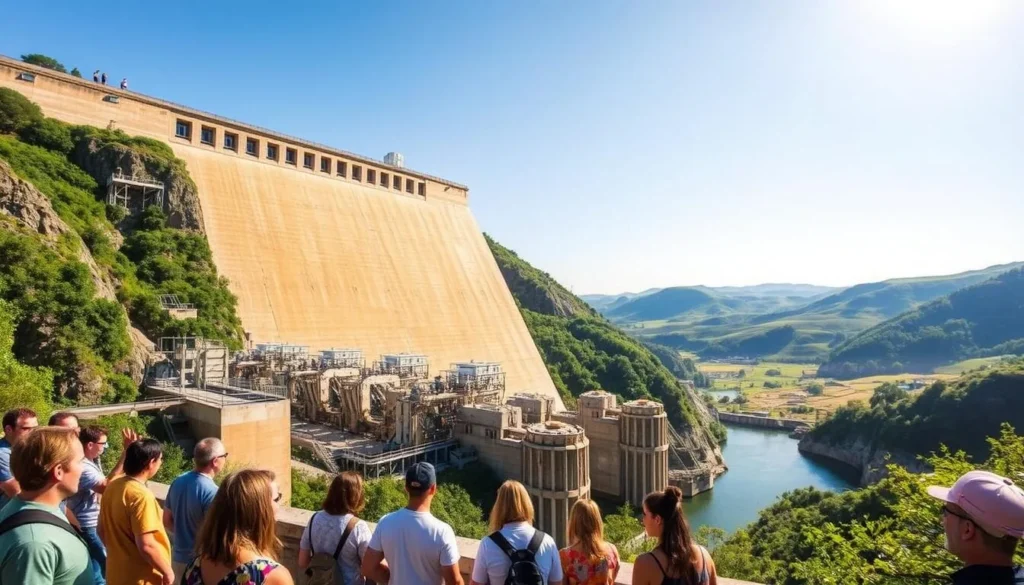
Interactive Exhibits and Demonstrations
The interactive exhibits at the hydroelectric plant are designed to be accessible to visitors of all ages, making complex concepts simple and fun to understand. Through hands-on demonstrations, you’ll see firsthand how water power is converted into electricity. These exhibits not only educate but also inspire, highlighting the importance of renewable energy sources. Visitors can engage with the equipment and ask staff members questions to deepen their understanding of the hydroelectric process.
By exploring the dam and hydroelectric plant, you’ll gain a deeper appreciation for the innovative way that Mammoth Spring State Park utilizes its natural resources to educate and inspire its visitors.
Family Fun at the Fish Hatchery
If you’re traveling with kids, the fish hatchery at Mammoth Spring State Park is a must-visit attraction that promises an exciting experience. The hatchery is not just a place to observe fish; it’s an interactive spot where your family can engage in various educational and entertaining activities.
Learning with the Kids
The fish hatchery offers educational opportunities that are perfect for kids. You can learn about the different species of fish raised at the hatchery and their importance to local ecosystems and recreational fishing. The staff are knowledgeable and happy to answer any questions you or your kids might have.
Feeding the Fish and More
One of the highlights of visiting the hatchery is the chance to participate in fish feeding activities. Feeding times are announced at the hatchery, and visitors can get involved in this interactive experience. Beyond feeding, the hatchery offers other hands-on activities that make it a great place for family interaction. It’s a wonderful way to spend quality time with your family, creating memorable experiences for kids of all ages.
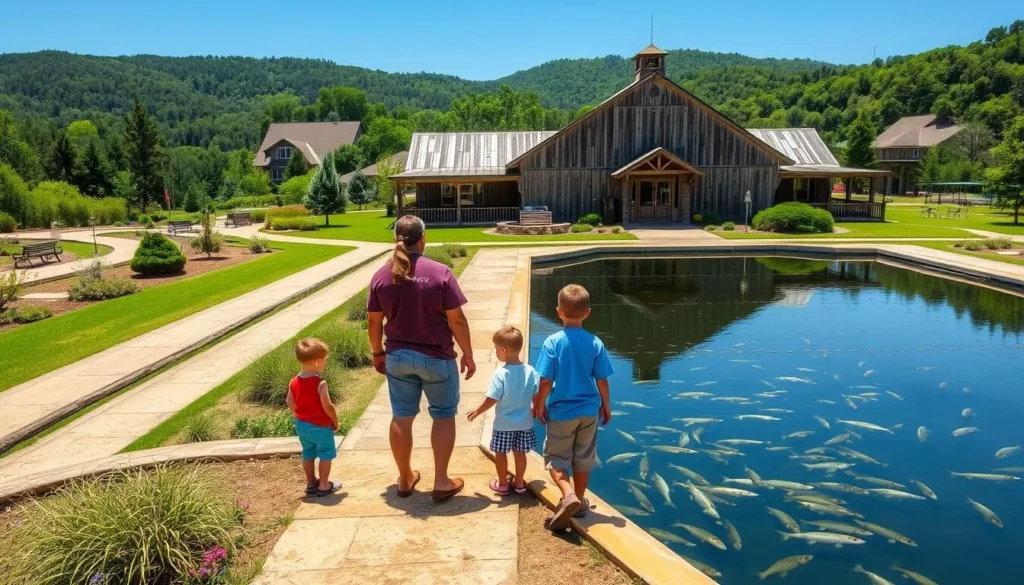
The fish hatchery at Mammoth Spring State Park is indeed a fantastic destination for a family outing, providing a mix of education and entertainment that caters to all ages.
Picnicking and Relaxation Spots
Mammoth Spring State Park offers serene environments perfect for picnicking and relaxation. As you visit the park, you’ll find numerous spots designed to help you unwind and enjoy the natural beauty surrounding you.
Best Picnic Areas in the Park
The park features several picnic areas, each offering a unique and peaceful atmosphere. You can picnic under the shade of trees or near the spring, enjoying the soothing sounds of flowing water. These picnic areas are equipped with necessary facilities to make your visit comfortable. Whether you’re looking to spend time with family or friends, these spots are ideal.
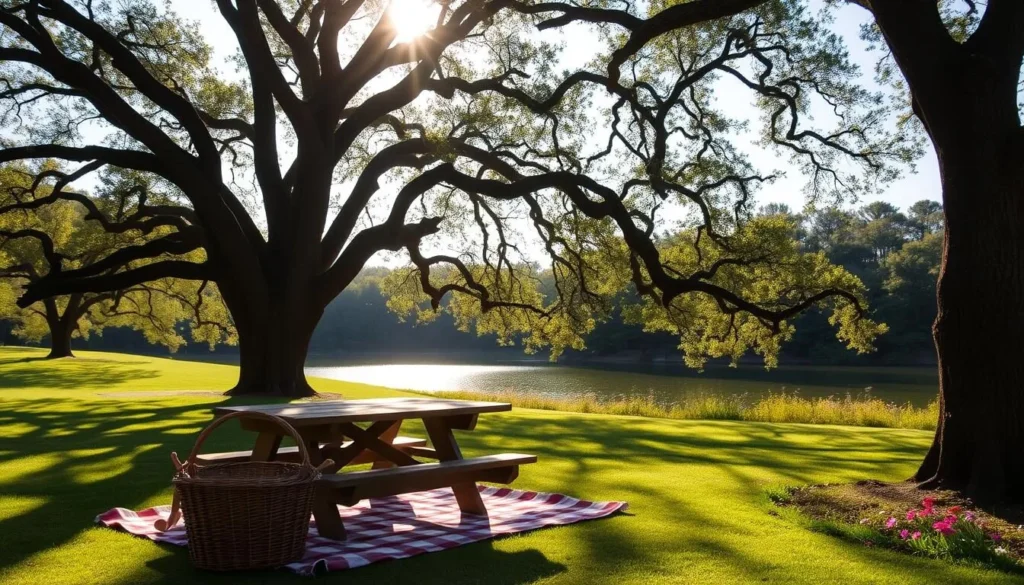
Scenic Spots for Relaxation
For those seeking relaxation, the park provides various scenic spots where you can sit and enjoy the tranquil surroundings. Benches and gazebos are strategically placed to offer beautiful views of the spring and the landscape. You can engage in activities like reading, meditation, or simply watching the water flow. Visiting during the early morning or late afternoon can help you find solitude in these spots, allowing you to truly relax and unwind in the peaceful park area.
The Connection to Grand Gulf State Park
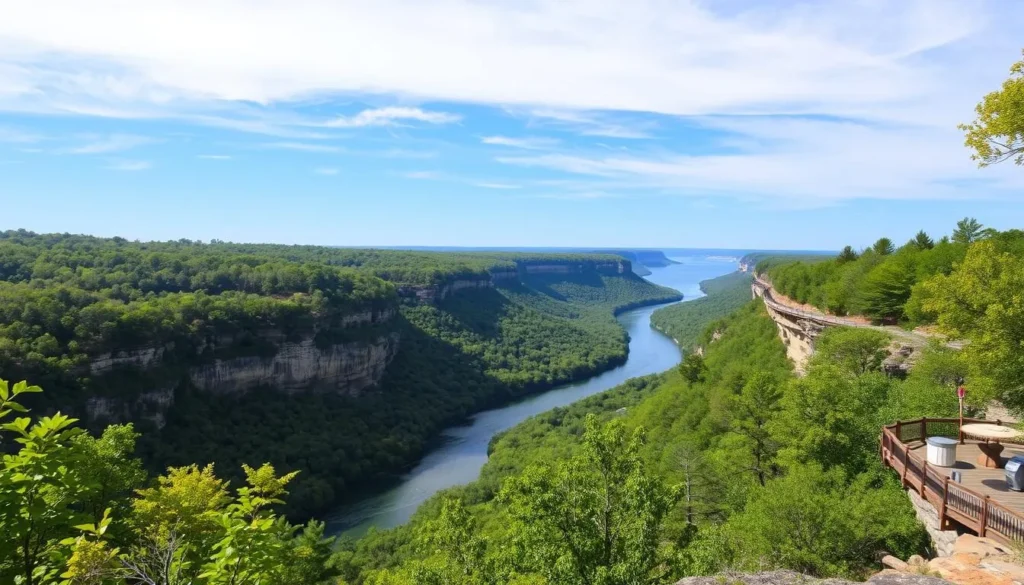
A trip to Mammoth Spring State Park can be seamlessly extended to include Grand Gulf State Park, located just a short drive away. Grand Gulf State Park, often referred to as Missouri’s Little Grand Canyon, is a fascinating destination that complements the natural beauty of Mammoth Spring.
The Underground Water System
The water that flows through Grand Gulf State Park’s “Little Grand Canyon” eventually emerges at Mammoth Spring, creating a unique hydrological connection between the two parks. This underground water system is a remarkable natural phenomenon that highlights the region’s geological complexity.
Understanding this connection enhances your appreciation of the regional geology and hydrology, making a visit to both parks a more meaningful experience.
Planning a Visit to Both Parks
To make the most of your trip, plan to visit both Mammoth Spring State Park and Grand Gulf State Park in one day. The driving distance between the two parks is approximately 13 miles, with a driving time of about 15 minutes.
Here’s a suggested itinerary: Start your day at Grand Gulf State Park by hiking its trails and exploring the “Little Grand Canyon.” Then, head to Mammoth Spring State Park to witness the massive spring and explore the surrounding area. Be sure to visit the Historic Frisco Depot Museum and enjoy a picnic in one of the scenic areas.
When visiting both parks, it’s a good idea to pack accordingly, bringing comfortable hiking shoes, water, and snacks. By combining these two destinations, you’ll gain a deeper understanding of the region’s natural beauty and geological significance.
Seasonal Activities at Mammoth Spring State Park
As the seasons change, Mammoth Spring State Park transforms into a diverse playground for outdoor enthusiasts. The park’s natural beauty and recreational opportunities make it an ideal destination for visitors throughout the year.
Spring and Summer Highlights
During the spring and summer months, Mammoth Spring State Park is in full bloom. The Spring River is perfect for a day of fishing or canoeing, while the trail network offers scenic views of the surrounding landscape. Visitors can enjoy a leisurely day out on the trail, taking in the vibrant flora and fauna.
The warm weather also brings opportunities for picnicking and relaxation. You can spend a peaceful day at one of the many picnic areas, enjoying the serene atmosphere of the park.
Fall and Winter Experiences
As fall arrives, the forests surrounding Mammoth Spring display a kaleidoscope of colors, creating spectacular views from the trail overlooks. The cooler weather makes for a comfortable day out, whether you’re hiking or simply enjoying the scenery.
Winter brings a mystical atmosphere to the park, as the 58-degree spring water creates steam when air temperatures drop. This phenomenon, combined with the potential for spotting seasonal wildlife, makes winter a unique time to visit. Visitors should dress warmly and be prepared for cooler weather to fully enjoy the Spring River and surrounding areas.
| Season | Activity | Highlights |
|---|---|---|
| Spring/Summer | Fishing, Canoeing, Hiking | Vibrant flora, Scenic views |
| Fall | Hiking, Wildlife Viewing | Colorful foliage, Comfortable weather |
| Winter | Steam viewing, Wildlife spotting | Mystical atmosphere, Unique landscapes |
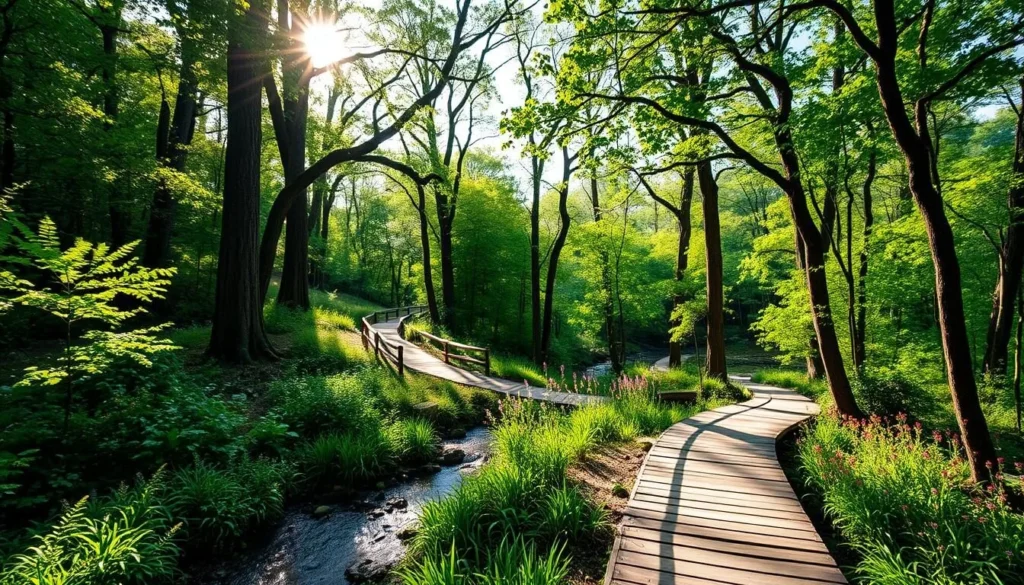
Practical Information for Your Visit
Planning a visit to Mammoth Spring State Park requires some practical information to make the most of your trip. Understanding the logistics will help you enjoy your time exploring this natural wonder.
Getting There and Parking
Mammoth Spring State Park is located in the Ozark Mountains, making it an ideal destination for those looking to spend time in nature. To get there, take Highway 63 to Mammoth Spring, AR. The park offers ample parking near the spring and other attractions. Make sure to arrive early during peak seasons to secure a parking spot.
Operating Hours and Admission Fees
The park is open year-round, but the operating hours vary by season. Admission fees are reasonable, making it an affordable outing for families. You’re looking for a budget-friendly activity; this park fits the bill. Check the official park website for the most up-to-date information on hours and fees.
Nearby Accommodations
For those planning to stay in the area, there are various lodging options within a few miles of the park. You’re looking for hotels, motels, bed and breakfasts, or campgrounds? Nearby towns like Mammoth Spring, AR, and Thayer, MO, offer a range of choices. When booking, consider the proximity to the park to make the most of your visit. Prices vary, so it’s a good idea to book in advance, especially during peak tourist seasons, to ensure availability and get the best rates. You can expect to spend around $80 to $150 per night for a hotel, while campgrounds offer more budget-friendly options starting from $20 per night.
Conclusion: Why Mammoth Spring State Park Should Be On Your Arkansas Bucket List
With its unique blend of natural and historical attractions, Mammoth Spring State Park stands out as a top destination in Arkansas. The park is home to the impressive Mammoth Spring, producing nine million gallons of water per hour, creating a breathtaking spectacle.
Visitors can explore the Frisco Depot Museum, enjoy the Fish Hatchery, or take a leisurely walk along the Spring Trail, offering scenic views and a glimpse into the park’s rich history. This state park is an ideal destination for family adventures, with its diverse attractions and educational opportunities.
Whether you’re looking for a full day of exploration or a peaceful stop on your way back from other Ozark adventures, Mammoth Spring State Park is a must-visit place that should be on your Arkansas bucket list.
The above is subject to change.
Check back often to TRAVEL.COM for the latest travel tips and deals.
